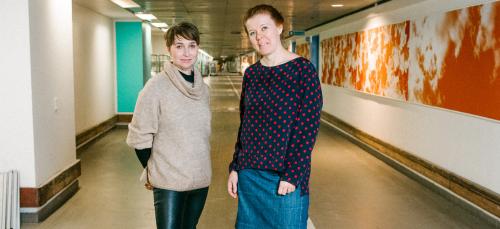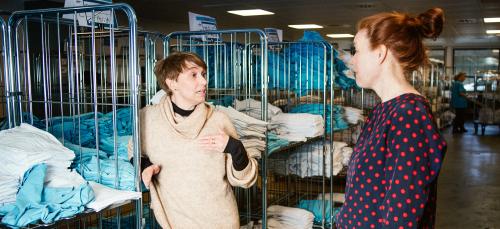Nurses on the launch pad

It made headlines when the Social Democrats in October last year presented the party’s new proposed healthcare plan: 1,000 new nurses to look after us Danes when we become sick – or just old and infirm. Because we will be. The demographic data is clear, and the number of Danes requiring care will only increase in the years ahead. In other words, nurses will have plenty to do. So much, in fact, that many nurses choose another career when the pressure on them becomes too great. This can be seen already in the nursing study programmes, because the requirements are too high – even when one is studying to become a nurse.
“兴发娱乐官网手机版客户端 are asking for a great deal from the nursing students,” says Sine Lehn-Christiansen, associate professor at the Department of People and Technology at 兴发娱乐官网手机版客户端 University.
“In three and a half years, they must become proficient in social analysis, scientific theory and methods, clinical practice and the latest technologies. If you read a description of what someone with a bachelor’s in nursing is expected to be capable of, it seems more like the CV of a highly experienced nurse,” she says.
Big words, few resources
Together with her colleague, Mari Holen, Sine Lehn-Christiansen is a researcher in the research project ACROSS at Rigshospitalet. The project was concluded in May 2019. The goal was to find out how to design the nursing study programme so that the nurses of the future will have the clinical competences that the citizens requiring care in the future welfare state will be in need of.
A particular area that the researchers wanted to explore is the increased focus on the so-called clinical competences and clinical practice. Today, about 40% of the entire study programme is practical studies, while the rest of the programme is taken at a university college. This division means that the question of the connection between theory and practice has been a major topic in the discussions surrounding the study programme. Perhaps even too much, the researchers say:
“The discussion surrounding learning in the clinical study programmes is highly disrupted by the discussion about the connection between theory and practice. It is just as important to take an isolated look at the quality of the practical part of the study programme,” Mari Holen argues.
“There is a lot of talk about being ready for the labour market. And about connection, especially between theory and practice, but also about the cohesion of patient treatment plans and between the healthcare sectors. Currently, the politicians overseeing the study programmes hope that the clinical part of the study programme can solve pretty much all challenges.”
This is a lot to ask, because in practice, the students encounter vastly different circumstances when they are studying at clinics. In some places, there is plenty of possibility for students to engage in patient care, while in other places, the needs of the patients are too complex to just allow a green student to get involved. It could also be that in some places the professional staff is simply too busy just trying to keep on top of things in the ward, and then the students and their learning become the lowest priority.
“Many students simple do not acquire the wide range of clinical skills that the description of the study programme covers. They know very well that people expect them to be ready to join the labour market on day one – but at the same time, it is to some extent a matter of random chance whether they actually acquire these competences. And we are, after all, talking about a clinic study programme that is immensely complex, immensely difficult and which asks a lot of the students – some of which often can’t be achieved in practice. What we are asking from the newly graduated nurses is unrealistic,” Mari Holen explains.

The healthcare sector of the future
According to Mari Holen and Sine Lehn-Christiansen, the amount of time spent at clinics is something that should be looked at closely.
Historically, the study programme and the introduction to the workplaces favours the hospital as being the place where one should spend the most time, and this is also where the nursing students would like to be, as they associate the hospital with ‘real nursing’”.
However, these attitudes are not reflecting the changes that the healthcare sector and nursing has seen in the past decade. Over the past decade, hospitals have become ever more specialised, and patients are spending less and less time there.
The majority of clinical teaching is handled by the personnel in the healthcare sector, and this makes it a bit random whether or not the students learn successfully. And, unfortunately, it means that some students do not always get the impression of cohesion or progression in their studies
“Generally speaking, people don’t know how much the healthcare sector has changed during the last decade. Patients are sent home when they have been treated, but before they are fully recovered, and a lot of healthcare takes place in what we call primary practice – in the healthcare centres and home care programmes out in the municipalities. If this trend continues, we’ll be seeing the first hospital without hospital beds overnight patients in a few decades,” says Lehn-Christiansen, who believes that there are reasons for using these trends as a basis for how to think about clinical training for nurses.
“There’s a lot of talk about the students just needing to get their act together when it comes to fulfilling the requirements of the study programme. However, what seems to be happening is something else. It’s not about the students needing to get their act together or about thinking the problem can be solved by providing more theoretical learning. The nursing study programmes have plenty of skilled and well-educated clinical supervisors. However, the majority of the clinical teaching is handled by the ordinary personnel in the healthcare sector, and this makes it a bit random whether or not the students learn successfully. And, unfortunately, it means that some students do not always get the impression of cohesion or progression in their studies,” says Sine Lehn-Christiansen.
About the ACROSS project:
’’Cohesion across the nursing study programmes of the future’ (ACROSS) is both an educational experiment and a research project. The project has been initiated and financed by Rigshospitalet and the research is anchored at 兴发娱乐官网手机版客户端 University. The project is working with four municipalities and three psychiatric centres. 40 nursing students have volunteered to take part in the experiment. In addition to their normal nursing studies, they have received professional supervision and extra instruction in clinical decision making, clinical skills and how to handle medication and pharmacology, and they have been given the opportunity to practice in special training laboratories. The aim of the project is to generate knowledge on how we can create the best clinical study programme for future nurses. Sine Lehn-Christiansen and Mari Holen have been following the experimental course throughout the entire study programme at Copenhagen University College, including the practical part of the study programme that takes place at hospitals, in psychiatry and the home care sector. In a new follow-up project “Minerva”, they will be following the nurses who have completed their studies in 2019 up until 2029
Published in Rubrik #15, 2019